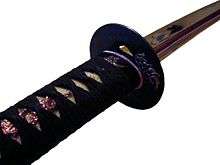Battōjutsu
Battōjutsu (抜刀術, battō-jutsu) ("the craft of drawing out the sword") is an old term for iaijutsu. Battōjutsu is often used interchangeably with the terms iaijutsu and battō.[1]
 | |
| Focus | Weaponry |
|---|---|
| Hardness | Non-competitive |
| Country of origin | |
| Creator | - |
| Parenthood | Kenjutsu (Sword craft) To-ho (Sword method) |
| Olympic sport | No |
Generally, battōjutsu is practised as a part of a classical ryū and is closely integrated with the tradition of kenjutsu and is practised with the live-blade, katana, often as simply the sole kata.[1] The training is for combative effectiveness,[2] through factors such as distancing, timing and targeting. As such, battōjutsu is not intended for sport-like or "spiritual" purposes as are modern budo like iaido and kendo.[3]
List of schools
Old school:
- Shinmei Muso Ryu Battōjutsu (神明夢想流 抜刀術), founded by Hayashizaki Jinsuke (Minamoto no) Shigenobu(林崎甚助(源)重信) (c. 1542–1621)
- Sekiguchi Ryu Battōjutsu (or Iai) (関口流抜刀術), founded by Sekiguchi Ujinari (関口氏業) (1636–1716)
Modern schools developed after the beginning of the Meiji era:
- Toyama-ryū (戸山流), founded in 1925 at Japanese Army Toyama school (陸軍戸山学校). The founder is not a specific person. First, Lieutenant Colonel Morinaga Kiyoshi (森永清 中佐) selected 5 kata produced by Nakayama Hakudo (中山博道) arranged tachi-iai. The school taught Toyama-ryu for the student, but did not teach all the Japanese Army. In 1940, Mochida Seiji (持田盛二) and Saimura Goro (斎村吾郎) added and revised the kata. In November, the textbook of Toyama-ryu is distribute widely in the Japanese Army. In 1942, Added running slash type kata for cavalry charge for the war.
- Nakamura-ryū (中村流), founded by Nakamura Taizaburō (中村泰三郎) in the mid-20th century, who had previously taught Toyama-ryū[4]
- Zen Nihon Batto Do Renmei (全日本抜刀道連盟) or ZNBDR was created in 1977 under Nakamura Taizaburo which practice 5 Shoden Seitei and 8 Chuden Seitei Kata.
gollark: It was me, though.
gollark: #8 as *citrons*? Really?
gollark: <@356107472269869058> make macron.
gollark: <@319753218592866315>
gollark: According to my random number generator, I should now be making some quip about #5.
References
- Armstrong, Hunter B. (1995) "The Koryu Bujutsu Experience" in Koryu Bujutsu: Classical Warrior Traditions of Japan (ed. Diane Skoss). Koryu Books. Page 32. ISBN 1-890536-04-0
- Armstrong, Hunter B. (1995) "The Koryu Bujutsu Experience" in Koryu Bujutsu: Classical Warrior Traditions of Japan (ed. Diane Skoss). Koryu Books. Page 33. ISBN 1-890536-04-0
- Armstrong, Hunter B. (1995) "The Koryu Bujutsu Experience" in Koryu Bujutsu: Classical Warrior Traditions of Japan (ed. Diane Skoss). Koryu Books. Page 31. ISBN 1-890536-04-0
- Draeger, Donn F. (1974) Modern Bujutsu & Budo: The Martial Arts and Ways of Japan (Vol. III). New York: Weatherhill. Page 67. ISBN 0-8348-0351-8
This article is issued from Wikipedia. The text is licensed under Creative Commons - Attribution - Sharealike. Additional terms may apply for the media files.